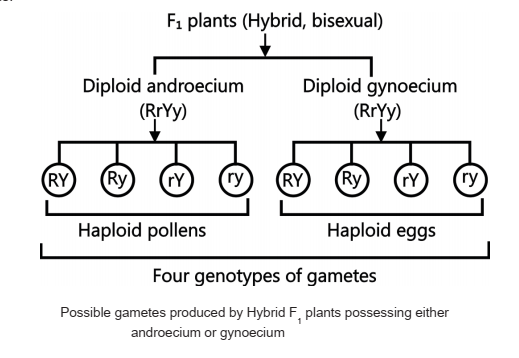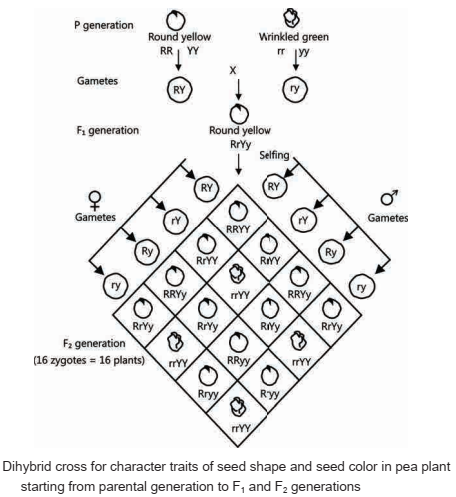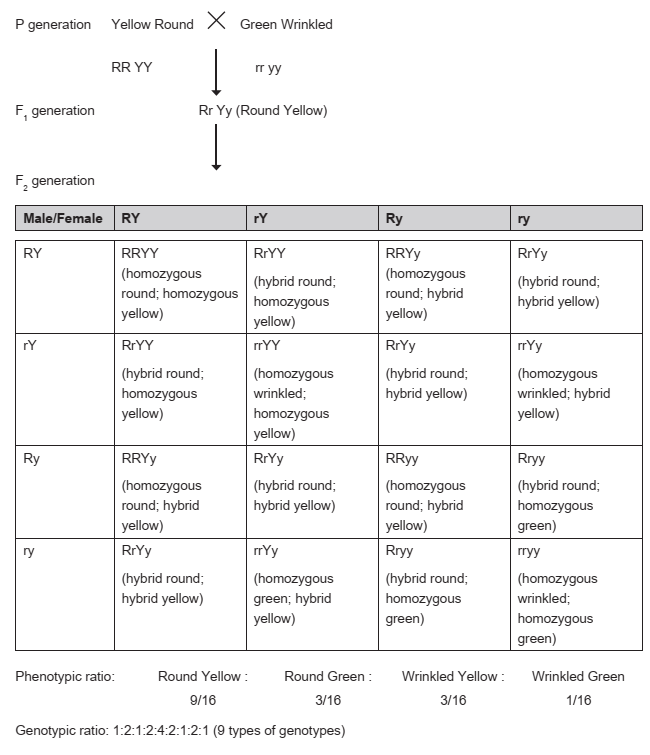Mendel’s Three Laws Of Inheritance
Gregor Mendel conducted hybridisation experiments on garden peas for seven years (1856-1863) and proposed the so-called Mendel’s Laws Of Inheritance in living organisms. Before going into the details of the Mendel’s Laws of Inheritance, we must first understand the experiment performed by Mendel.
Mendel’s Experiment On Pea Plants
Among the traits that Mendel studied were the colour of a plant’s flowers, their location on the plant, the shape and colour of pea pods, the shape and colour of seeds, and the length of plant stems. Mendel’s approach was to transfer pollen from the stamen of one pea plant to the pistil of a second pea plant.
His experiments had an outsized sampling size, that gave greater credibility to the data that he collected. Mendel investigated characters in the garden pea plant that were manifested as two opposing traits, E.g. Tall or dwarf plant; yellow or green seeds. The seven contrasting characters that were studied by Mendel are:
- Tall vine Vs Dwarf vine
- Axial flowers and pods Vs Terminal flowers and pods
- Light or dark green pods Vs Yellow pods
- Non-constricted or full pods Vs Constricted pods
- Grey seed coat Vs White seed coat
- Yellow endosperm Vs Green endosperm
- Round seeds Vs Wrinkled seeds
Inheritance of One Gene
Mendel discovered that the “F1 generation” (first filial generation) was comprised entirely of individuals exhibiting only one of the traits. However, when this generation was interbred, its offspring, the “F2” (second filial generation), showed a 3:1 ratio i.e. 3 individuals had the same trait as one parent and 1 individual had the trait of the other parent. Mendel then theorized that genes can be made up of three possible pairings of heredity units, which he called ‘factors’: AA, Aa, and aa. The ‘A’ represents the dominant factor and the ‘a’ represents the recessive factor. In Mendel’s crosses, the starting plants were homozygous AA or aa, the F1 generation was Aa, and the F2 generation was AA, Aa, or aa. The interaction between these two determines the physical trait that is visible to us.

Similar results were obtained with the other traits that he studied: only one of the parental traits was expressed in the F1 generation while at the F2 stage both the traits were expressed in the proportion 3:1. The traits did not show any blending at either F1 or F2 stage.
A British geneticist, Reginald C. Punnett developed a square-like diagram called Punnet Square to understand the production of gametes by the parents, the formation of the zygotes, the F1 and F2 plants. It is a graphical representation to calculate the probability of all possible genotypes of offspring in a genetic cross. The ratio is
Phenotypic ratio = 3 (Tall) : 1 (dwarf)
Genotypic ratio = 1 (TT tall) : 2 (Tt tall) : 1 (tt dwarf)
Mendel’s Three Laws Of Inheritance
Mendel’s observations and conclusions are summarized in the following three principles, or laws called as Mendel’s Laws Of Inheritance.
Law of Dominance – Mendel’s First Laws Of Inheritance
The Law of Dominance states the expression of only one of the forms of the parental traits in the F1 hybrid, i.e. the F1 generation always display only one of the parent traits. He described that trait which was always seen in F1 generation as dominant and the trait that disappeared as recessive.
Law of Segregation – Mendel’s Second Laws Of Inheritance
The Law of Segregation states that for any trait, each pair of alleles of a gene split and one gene passes from each parent to an offspring.


Law of Independent Assortment – Mendel’s Third Laws Of Inheritance
The Law of Independent Assortment states that completely different pairs of alleles are passed onto the offspring independently of each other. Therefore, the inheritance of genes at one location in a genome doesn’t influence the inheritance of genes at another location. Mendel crossed pea plants differing in two characters (dihybrid cross) to verify the results of monohybrid crosses. This helped him to understand the inheritance of two pairs of factors at a time. A cross was made between a pure round yellow-seeded pea plant (RRYY) with wrinkled green-seeded pea plant (rryy). The yellow colour is dominant over green and rounded seed shape over wrinkled seed shape.
Mendel found that plants of the F1 generation have all yellow and round seeds because yellow and round traits are respectively dominant over green and wrinkled traits. These results were just like those that he got when he made separate hybrid crosses between yellow and green seeded plants and between round and wrinkled seeded plants.
